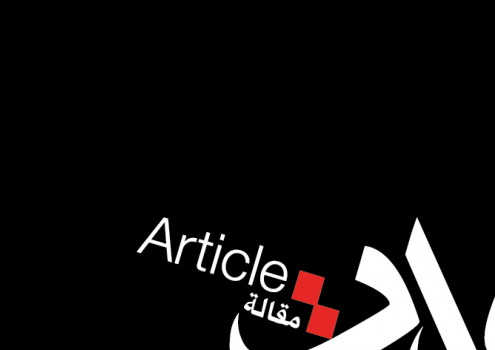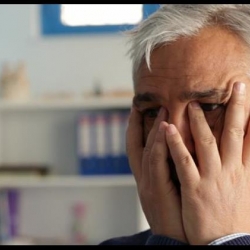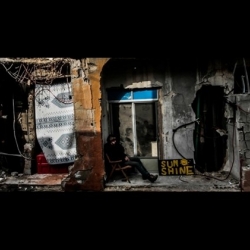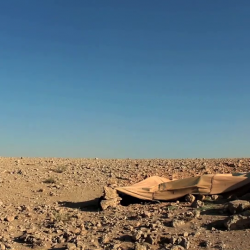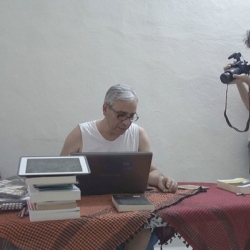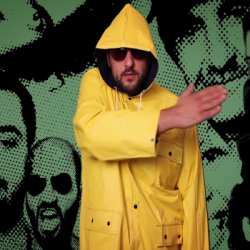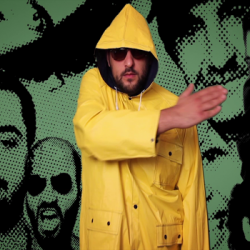|
Earlier this month at the FIDMarseille international film festival, the Competition Grand Prize went to a feature-length documentary called “Our Terrible Country.” This Syrian-Lebanese co-production was co-directed by Mohammed Ali Atassi and Ziad Homsi, Syrian filmmakers of two generations. A road movie of sorts, “Our Terrible Country” documents another inter-generational relationship.
It follows dissident Syrian intellectual Yassin Haj Saleh as he treks from Douma, northeast of Damascus, to Raqqa, the northern town where he was born, then into exile in Turkey. It is an emotional passage. Haj Saleh was forced to leave his wife in Douma. Homsi, who accompanied the dissident on his journey to Raqqa, was detained by Salafi insurgents.
A well-known figure in these parts, Atassi has made documentaries about Syrian communist dissident Riyad al-Turk and Egyptian intellectual Nasr Hamed Abu Zayd. The latter, “Waiting for Abu Zayd,” was feted at the FID in 2010. Unknown to most audiences is 20-something Ziad Homsi, Atassi’s freshman co-director and Haj Saleh’s co-star.The FID win marks a sort of debut for the producers of “Our Terrible Country,” a documentary film engine called Bidayyat. Founded in 2012, Bidayyat offers development funds and workshops for freshman and sophomore filmmakers from Syria.
Speaking on behalf of Bidayyat, Atassi says the organization grew out of an earlier initiative devoted to training Syrian media activists. “You know, with YouTube and the citizen journalists, the false became true and the true false,” he recalled. “It was very difficult to work [with] no people on the ground [to] check the facts. We don’t have a documentary film school in Syria. With what’s happening in Syria, the image became the frontline of the conflict. Everything was moving through the image. The [question of] authenticity posed a big dilemma. I think a lot of young people were forced from the beginning to look to what’s happening in Syria via the image.”
“When we were working that first year,” added a Bidayyat member who prefers to remain anonymous, “we felt that the most interesting part of the stories were usually ... [activists’] personal [reflections on] what they’d witnessed, how they have been affected, how things have changed. ... The facts of what happened were rather less interesting than the personal dimension of this person who was reporting.”
This dimension is important, she continued, because, “after two or three years of reporting on Syria, people get tired. They can’t really relate anymore. It’s just another story that won’t finish.” Creative documentary, she continued (whose adherents explore cinematography and narrative as ways of telling stories obliquely) is still quite new to these aspiring filmmakers. “For them, documentaries were what they saw on the Arabic and English SAT [satellite] channels – ‘objective,’ neutral journalism, reporting a story. To allow yourself to play with notions of fiction and reality was something completely new. I think this is something very appealing. ... As Ali always says, in Syria today reality is really stronger than fiction.”
Bidayyat has a managing board comprised of prominent Lebanese and Syrian filmmakers. It is sponsored by a respected German foundation and has received funding from agencies in a handful of European countries. “What’s important for us is that we have several donors,” Atassi said, “not one. Our donors don’t have a political agenda in the way the big powers do. This gives you some flexibility and independence.”
As one member described it, Bidayyat’s workshop program aspires to the industry standards set by film funds around the world, while putting the emphasis on the needs of individual projects. “We try to have different modules, where people learn different skills,” she said. “The other approach we have is to give space for the individual development of film projects – a lot of one-to-one sessions, where people could really go through all the questions they have, and go through their footage.
“We usually try to work with Arabic-speaking mentors. Language is important in the creative process, so most times we work with people from the region who are either based here or come periodically from Europe. Exchange between established and emerging filmmakers is important. We try to [avoid] these three-day-long five-star-hotel workshops, that end up being very general, [in favor of working] on specific projects – small groups working over a week or so – and then offer individual follow-up in the middle and long term.”
Several Syrian artist collectives have attracted media attention since 2012. The filmmakers in the anonymous collective Abounaddara, for instance, shoot miniature works that evince documentary principles much like those of Bidayyat. Atassi notes that Bidayyat’s aesthetic is necessarily distinct.
“We work with emerging artists,” he said, “with cinéma d’auteur. Working with young artists, helping them make their first films, you cannot say your objective is always to go to the highest standard. It’s about the auteur’s point of view. It’s not our role to tell ... who’s bad and who’s good. It’s not only a political point of view. It’s an artistic point of view also, a human point of view. It is clear what is happening in Syria. The regime is a criminal regime. It’s not our role to provide proof of the crimes. It’s our role to tell what is happening to the people. When ... the Islamists’ violations of human rights began, it was important to take that into consideration, to critique power, no matter if it’s the regime or the Islamists.”
Atassi said Bidayyat was under no illusion that it’s somehow “countering” international media representations of the Syrian conflict. “Looking at what all the other artists on the Syrian art scene are doing today,” he said, “in painting, music, short film, documentaries, I think they are [telling a] more complicated and rich story that what we are seeing in the mass media.”
“I think one of the major aims of Bidayyat is to free emerging filmmakers from the very rigid demands of television and production companies,” added another Bidayyat member. “We want to provide a space where young filmmakers can find their own visual language. "News media has trouble even providing contradicting points of view, [and so is] forced to draw conclusions. This is something you don’t have to do in art. You’re not forced to give answers. You can ask questions. After three years and a half, I think people do have a lot of questions to ask.”
Copyrights 2014, The Daily Star - All Rights Reserved
24/07/2014
|



